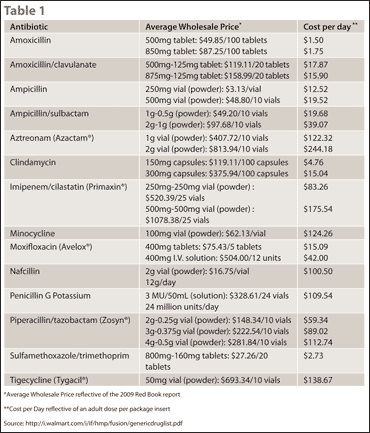Antibiotic cost: Not always correlated with drug novelty
Click Here to Manage Email Alerts
The recent economic recession has left many of us striving to improve our fiscal fitness and incorporate less expensive options into all aspects of our daily lives. The antimicrobial budget, which can account for up to 30% of drug expenditures at many institutions, is not immune to these effects. Often, clinicians attempt to choose older, generic anti-infective medications to try and minimize costs to the institution or individual patient. A frequent frustration is that clinicians only learn after the fact that some of these older treatments can also carry a significant price tag.

The reasons for the high cost of older medications are multifactorial. In many cases, there is a single manufacturer for these agents; this has been demonstrated by the recent drug shortages of vital therapies such as intravenous penicillin and conventional amphotericin B. The resultant increase in demand can bring with it a rise in cost that does not disappear when drug supplies are replenished. There are other reasons as well, including that many of these agents can be expensive to produce and that expense does not dissipate when patents expire.
Just one example centers on the recent reintroduction of intravenous minocyline in the United States in May. Minocycline has become an attractive agent against a wide variety of nosocomial and community-acquired infections, including multidrug resistant Acinetobacter baumannii and Stenotrophomonas maltophilia. This antibiotic stimulates great interest, as it has potential to become an important part of the armamentarium against these clinically important pathogens. However, this older antibiotic, originally approved by the FDA in 1971, does not come with a discounted charge. The cost-per-day of parenteral minocycline is comparable with similar, newer agents in its class, such as tigecycline, which was approved by the FDA in June 2005.
Currently available agents
Table 1 provides a list of some currently available anti-infective agents that are commonly used in both hospital and community practices. The average wholesale price (AWP) was extracted from the 2009 Red Book report, a United States pharmacy reference that standardizes the latest pricing and product information on prescription and over-the-counter medications. The cost-per-day was determined based on the recommended adult daily dose provided by the manufacturer package insert. The dosing regimens were not adjusted for renal or hepatic impairment or pharmacokinetic or pharmacodynamic drug interactions. As an important reminder, institutional contracting prices vary greatly from AWP, making it difficult to determine the exact cost for any individual patient. Comparing AWP for different agents, however, should serve as a useful demonstration of the relative pricing for these various agents.

Further examples of counterintuitive pricing occur with the beta-lactam antibacterials. The penicillin antibiotics have been used in clinical practice since the mid-1900s. Although many penicillin derivatives are now obsolete, this diverse group of antibiotics is still widely used in clinical practice. Given its age, long history of use and generic status, many providers consider penicillin to be relatively inexpensive and an economical treatment option when clinically appropriate. Many practitioners are stunned to learn that a daily course of parenteral penicillin still tops $100 per day. Amoxicillin- clavulanic acid, FDA-approved in August 1984 and now available in generic forms, was the fifth most commonly prescribed antibiotic in 2008 in the community, with a 2.4% increase in prescriptions from 2007. While most would not be surprised that there is a marginal increase in cost over amoxillin alone, few would suspect a nearly 10-fold increase in cost-per-day compared with amoxicillin.
Comparing cost-per-day
Comparing the cost-per-day of various antimicrobials reveals unexpected differences, with some older antibiotics costing as much as 40 times more than their newer counterparts. The goal is not to eliminate the use of high-cost antibiotics but rather to be thoughtful and selective when using them. Alerting and educating providers about the cost of antimicrobial therapy per day is one way to stimulate discussion about whether the antibiotic is indicated and if there is a suitable alternative, including discontinuing unnecessary agents. In fact, such a discussion applies to all antibiotics, regardless of how long they have been available in the U.S. market.
In many instances, clinicians can strategically improve pharmaceutical costs by delivering leaner, yet appropriate, antimicrobial therapy without jeopardizing the quality of patient care. Preserving financial resources is a collective effort to selectively substitute lower cost but equally effective antibiotics whenever possible.
It is important to keep in mind that the choice of “older” and equally efficacious antibiotics does not always equate to cheaper antibiotics. By using a team-oriented, innovative approach, providers can play a pivotal role in choosing the most effective and economical antibiotics to tailor pharmacotherapy and preserving long-term financial vitality for institutions and patients alike.
Mary Butler, PharmD, is a resident in the Infectious Diseases Pharmacy Practice at the University of Rochester in Rochester, N.Y.
For more information:
